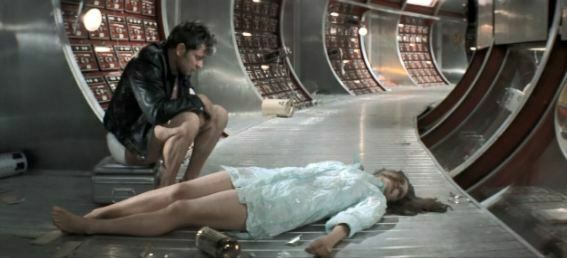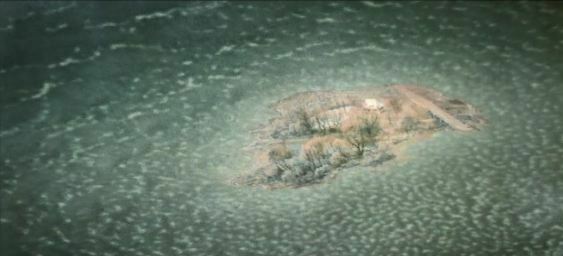
In a time of conflict, sing the songs of the other side.
I watched Solaris again the other night – the 1972 Soviet film, not its pale American remake. At the time of the crass, blind adventurism of the invasion of Ukraine, I felt the need to experience the finest of Russian culture. The film has long been a favourite. I think I first saw it when a teenager, bewildered but entranced much as the scientists in Andrei Tarkovsky‘s film are bewildered but entranced by the planet Solaris.
Solaris tells of a spaceship in close orbit around the mysterious, sentient planet Solaris. The two surviving scientist crew members are joined by a psychologist, Kris Kelvin, who has been sent to investigate tales of strange behaviour on the ship. He succumbs to the same fate as the others, which is to be haunted by human-like figures, in Kelvin’s case his wife Hari, who had committed suicide ten years earlier. These ‘visitors’ are the creations of the planet, whose swirling, living ocean can in some way read their minds and re-animate their memories. Kelvin tries to rid himself of Hari, initially by firing her out of the station on a rocket, but each time she returns, more human-like in her understanding of her situation. Realising the truth of her manufactured existence, Hari attempts suicide by drinking liquid oxygen, only painfully to come back to life again. Finally she and the other visitors are eliminated after the two scientists transmit Kelvin’s brainwaves to Solaris. Kelvin returns to Earth, or seems to.
Solaris succeeds so well as a film because it is an exposition of pure myth. It combines the clearest of ideas with the most resonant of results. A man encounters an alien world that can read his mind and bring memories back to life. In doing so the film touches on the most profound feelings about memory, loss, love, identity and place. It does so without the need for words – though there are plenty of them, since this is a Tarkovsky film and there are stretches in which men with gaunt faces exchange philosophical ideas, trying to find their place within the world in which they have found themselves. But the viewer does not much need the words, or they are not what one remembers. What we retain – the memory – is those haunted faces, the bewilderments and agonies of Kelvin and Hari’s love, of Hari the suicide brutally coming back to life, of the cuts from the action to the swirling, unknowable ocean of Solaris, playing with our minds. The familiar and the alien have never been brought together so well as they are in Solaris.
The film is based on a novel by Polish science fiction novelist Stanislaw Lem. Although the film faithfully recreates many elements of the book, the two are significantly different in several respects. Lem’s novel is a rich, complex work, but at heart it seeks to explain the inexplicable, whereas Tarkovsky focusses on its effects.

Lem, like any science fiction writer who wants to hold their head up high, impresses on us the science behind the fiction. The ‘visitors’ are explained by their basis in neutrinos rather than atoms. They are human-like but never entirely human. There is an scientific explanation for them. In the novel Rheya (the name is changed to Hari in the film) imitates a dead person. In Tarkovsky’s film she is the true Hari. A residue of the scientific explanation has been retained for the film, and we understand that her agony increases the more ‘human’ she becomes, but the visible truth is that she is the Hari who once was. We see it from the start. The progression lies in Kelvin’s understanding of this. It is their shared love that confirms it.
Lem goes to considerable trouble to describe the extraordinary landscape of the Solaris ocean, with its vast limb-like formations, its geysers, membranes, waves, ever-changing formations and its propensity for recreating objects. Tarkovsky simply gives us long shots of of swirling seas made out of acetone, aluminium powder, and coloured dyes. It is impossible to visualise what Lem tries to make us see. With Tarkovsky, we see all.

Lem collaborated with Tarkovsky on the film’s script and like so many authors before him he became exasperated by the deviations from his original. This was not just a question of tone but of narrative balance. The greatest difference between the two is the scenes on Earth. Lem’s novel takes place entirely in space, orbiting Solaris. The first quarter of Tarkovsky’s 169mins film takes place on Earth, with several flashbacks to Earth thereafter and the film’s unforgettable final image. The film’s first shots are of grasses swirling in the waters outside the home of Kelvin’s father. We do not know it as yet, but we are seeing a presentiment of the restless ocean of Solaris. Earth is as strange a place as Solaris; it is just as much a place of strangeness that plays on our memories, bringing that which was lost back to our consciousness. Knowing Earth is our best way of understanding Solaris.
We see more of Earth with the interviewing of space pilot Burton, whose account of fantastical figures conjured up by Solaris are dismissed by a sceptical committee as hallucinations. To the viewer his recollection of a four-metre tall baby feels like an uncanny presentiment of the Star Child in Stanley Kubrick’s 2001: A Space Odyssey (made in 1968, but the image is there in Lem’s 1961 novel), while Burton’s prolonged car journey into a faceless city feels like a parody of Kubrick’s ‘Star Gate’. Kelvin and Hari watch home movies in which Hari herself features, and at the end of the film a wretched Kelvin returns to his father’s home, a scene which is then revealed to be taking place on Solaris, their little piece of Russia a floating island in a sea of memories.

Maybe the whole film has been nothing but a creation of the planet Solaris, drawn from the memories of author and director, playing with our minds.
Lem is never so fanciful, but his novel embraces many more ideas than does the film, or at least explicitly so. His ideas on contact – the urge to communicate with the alien – are cited in Tarkovsky’s film, but almost as an aside rather than as a central theme. For Lem the compulsion and the failure to connect with the other bind everything together. His most celebrated words are put into the mouth of scientist Snaut:
We are humanitarian and chivalrous; we don’t want to enslave other races, we simply want to bequeath them our values and take over their heritage in exchange. We think of ourselves as the Knights of the Holy Contact. This is another lie. We are only seeking man. We have no need of other worlds. We need mirrors. We don’t know what to do with other worlds.
This is a bitter corrective to the romantic notion of exploration and discovery, but it is also a damning of the imperialist urge. Conquerors seek only to gain more of themselves, because they fear that which contradicts what they are, or appears to do. They would do better to understand themselves first, if ever they are able to do such a thing. Says Kelvin (in the novel):
I am a murderer unawares. Man has gone out to explore other worlds and other civilizations without having explored his own labyrinth of dark passages and secret chambers, and without finding what lies behind doorways that he himself has sealed.
Tarkovsky’s film does not have Kelvin’s lines, and may have Snaut say “We have no need of other worlds. We need mirrors” as much because the famous words are expected to be there as because they need to be. It is the point where novelist and filmmaker diverge. Tarkovsky was no imperialist, or nationalist, or prey to any other such false dreams, but his political view was shaped by his world. He defied the dictates of the state by extolling the private and the individual, eventually exiling himself from the Soviet Union so that he could continue to make the films he saw he had to make (Nostalghia in Italy, The Sacrifice in Sweden).

Lem came from another world. He was Polish, but he was born in Lwów, which at the time of his birth (1921) was in Poland, but is now familiar to all current news followers as Lviv, in Ukraine. Lviv has a long history of invasion, absorption into the worlds of others and imposition of alien identities. It has been part of Galicia, Poland, the Soviet Union, Ukraine, and kingdoms and empires long forgotten, its name ever-changing – Lvihorod, Lemberg, Lwów, Lvov, Lviv. For three years it was held by Nazi Germany, when thousands of its Jewish inhabitants were exterminated. It forms the geographical centrepiece of Philippe Sands’ modern classic, East West Street: On the Origins of Genocide and Crimes Against Humanity (2016). Sands is in the news himself, reviewing the terms under which the present Russian leader may be tried for war crimes.
Lviv, for Sands, is ‘a microcosm of Europe’s turbulent twentieth century, the focus on bloody conflicts that tore cultures apart’. It is a place of great beauty yet with dark secrets that our minds must bring to the surface, if we are human. It is a Solaris, of its kind.

Solaris is the mirror of our world, conjured out of our mind’s understanding of that world. It is God-like, of course (in the novel Snaut concludes that ‘Solaris could be the first phase of the despairing god’). It is place of conscience and consequences. Lem tries to analyse it; Tarkovsky shows the anguish of the process of discovery on his protagonists’ faces. The contact they have made is with themselves.
Solaris, the film, is a beautiful work of Russian art (though one must note that Tarkovsky’s poet father Arseny was Ukraine-born). One cannot imagine its like coming out of any other place. It is there in the combination of land and longing, of a particular coming together of romanticism and religion (an icon painted by Andrei Rublev, the artist subject of Tarkovsky’s previous film, can be seen in Kelvin’s room), of privacy in the face of a state that wants the reflection of everyone to be the same. Solaris the novel is the product of a different, perpetually overrun land, again and again made to belong to the worlds of others, a mirror of our follies.
Postscript: Vladimir Putin is on record as saying he joined the KGB after seeing the actor Donatas Banionis in a 1968 spy film, Dead Season. Four years later Banionis played Kris Kelvin in Solaris.
All images in this post are frame stills from the Artificial Eye DVD of Solaris (1972), top image cropped
A version of this post is included in my book Let Me Dream Again: Essays on the Moving Image (Sticking Place Books, 2025)
Oh yes some sci-fi! This has been on my to-do list for a while.
Hi Nathan. Do give it a go. There’s so much about it that’s good that I left out: the appealing grubbiness of the spaceship, Eduard Artemyev’s unsettling score, Brueghel, Kelvin’s naff clothes that look like he shopped at Primark, the obsession with knitwear, the levitation scene. And J.S. Bach.